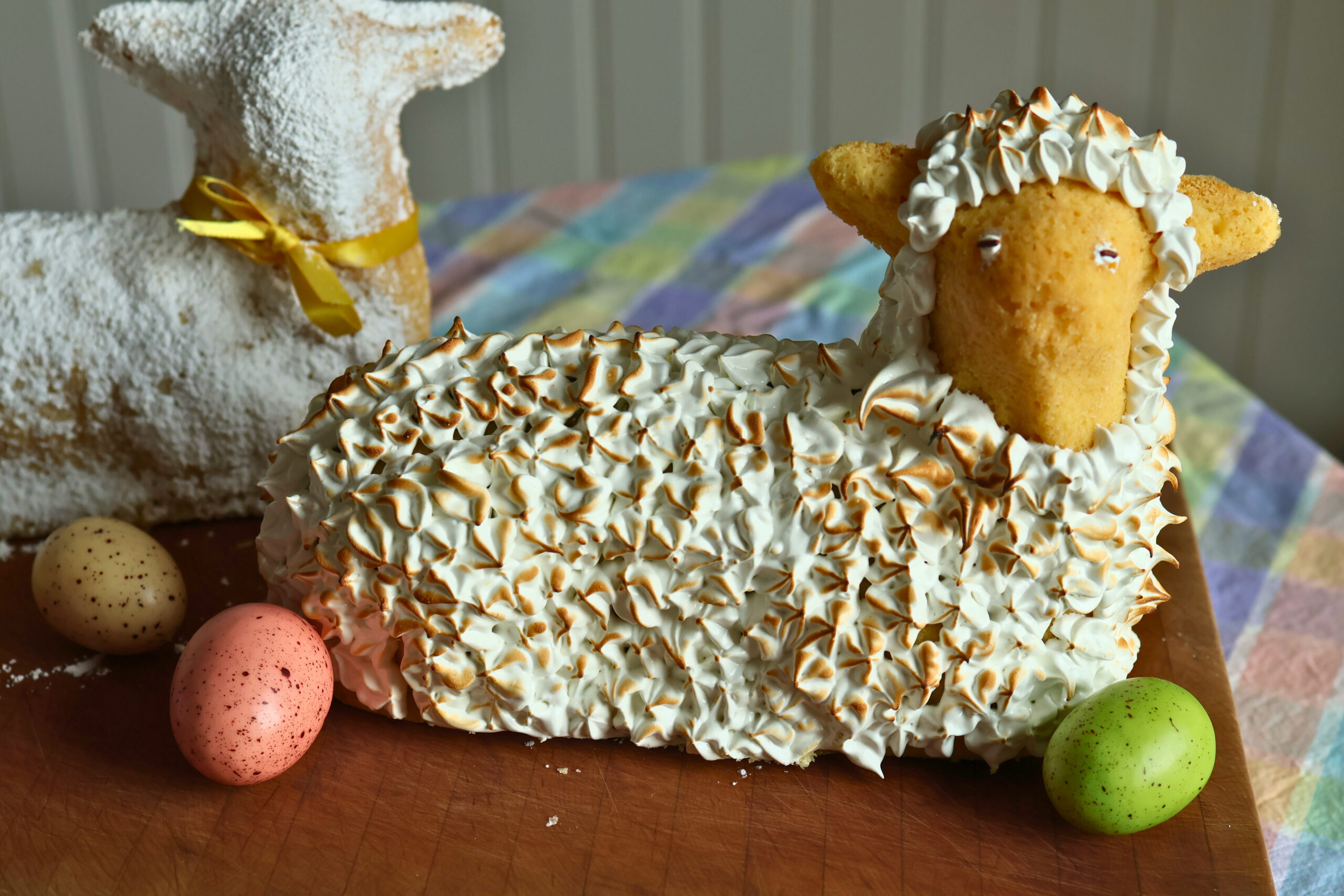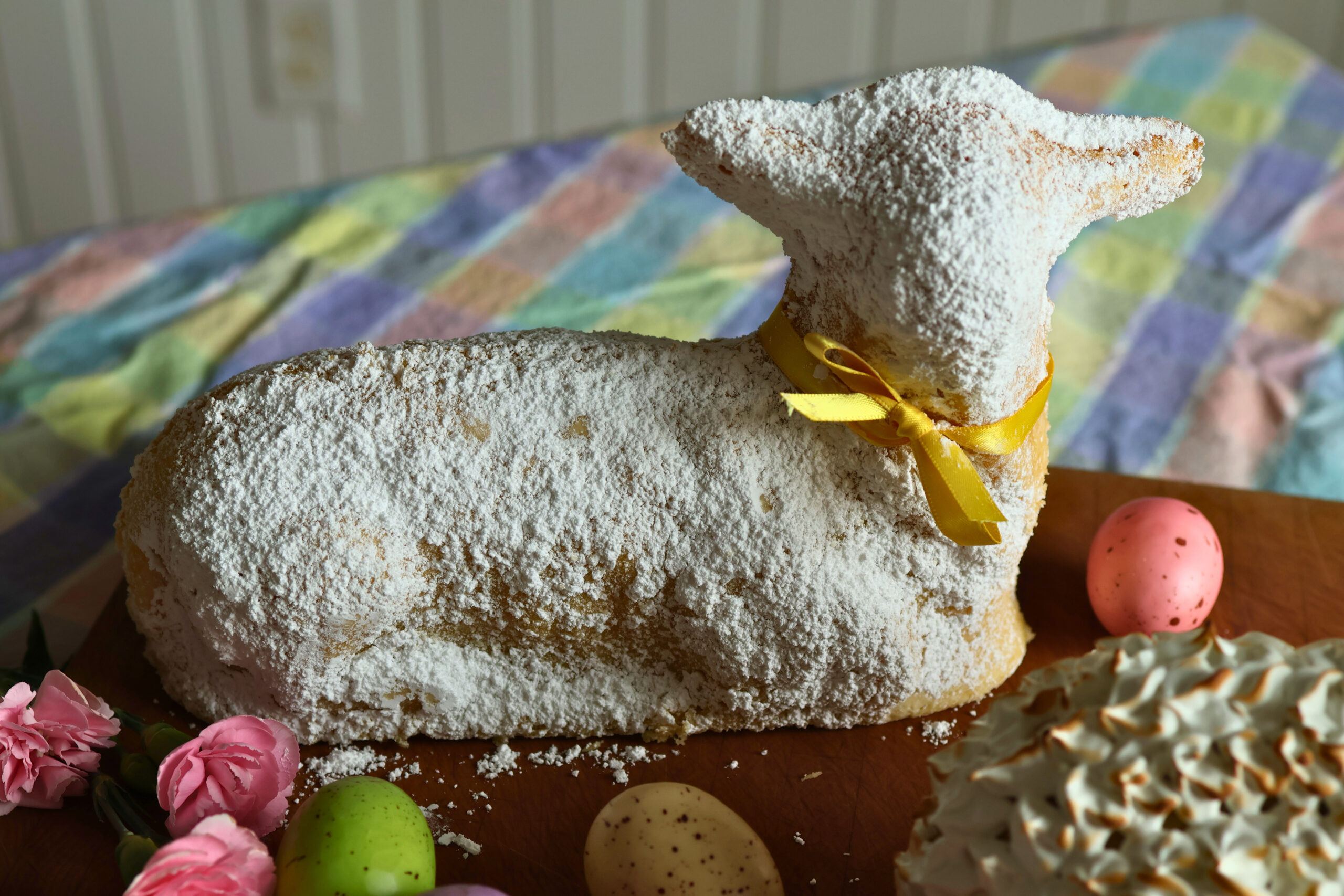

German Easter Lamb Cake | Osterlamm
A lemon-flavored sponge cake baked in the shape of a lamb for Easter. Traditionally, this cake is decorated with powdered sugar, but I also share with you a variation to pipe a Swiss meringue on the cake to look like sheep's wool.
Ingredients
Method
To Make the Cake
- Grease your lamb cake mold with a solid fat like butter or shortening, and then sprinkle the mold with semolina. You will want to use semolina here instead of regular, all-purpose flour because it will do a better job at keeping the cake from sticking to the surface of the pan. Cake pans that have a lot of nooks and crannies need a grittier flour like this so that the cake batter does not absorb it while baking. Place your prepared cake pans on a baking sheet and set them aside while making the batter.
- Add the powdered sugar, butter, lemon zest, lemon extract, and vanilla to a large bowl (or the bowl of a stand mixer) and beat the mixture with an electric mixer until creamy and light.
- Add the eggs one at a time, beating well after each addition. Scrape down the sides of bowl, as needed.
- In a separate, medium-sized bowl, whisk together the flour and baking powder, then add the mixture to the wet ingredients. Very briefly beat it just until combined. Then, briefly mix in the milk. Don't overwork the batter in order to keep the cake crumb tender.
- Spoon the batter into one side your prepared lamb mold. Spoon it into the side that does not have a steam hole. Use a spoon or spatula to pack down the batter to avoid air pockets while baking. Smooth it into each corner of the pan. Place the side of the cake pan that has a steam hole on top of the side filled with cake batter. Use kitchen twine to tie and secure each end of the cake pan, so that the lid does not pop off as the cake rises in the oven.
- Put the filled and secured cake pan on a baking sheet with the steam hole side up. Bake in a 350℉ / 180℃ pre-heated oven for 50-55 minutes. You can test the cake for doneness with a toothpick through the steam hole. This may not be the thickest part of the cake, however. If that is the case, it may be best to err on the side of the longer baking time to make sure the cake it cooked all the way through.
- Remove the baked cake from the oven and place on a rack to cool for 15 minutes before trying to remove it from the cake pan. When removing it take care to do it very slowly. Release any stuck edges before popping it out. Once removed, let the cake cool completely before decorating it. Once cool, you may need to slice a thin piece off the bottom to flatten it in order to allow it to sit level on your serving tray.
Decorating with Powdered Sugar
- If you'd like to decorate it the traditional way, lay the lamb down on one side. Dust it liberally with powdered sugar. Flip it over and dust the other side. Gently stand it back upright and dust again to cover any uncovered spots.
- If desired, you can tie a colorful ribbon around the neck of the lamb for added decoration. Make sure to remove the ribbon before eating.
Decorating with Swiss Meringue
- To make a Swiss meringue, create a double boiler using a medium-sized pot filled with 1 inch of water. Warm the water gently. Don't let it rise above a very gentle simmer.
- Add the egg whites and sugar to the bowl of a metal stand mixer and whisk the mixture until it is combined. Place the bowl on top of the pot with the simmering water to create a makeshift double boiler. Using the whisk attachment from your stand mixer, continually whisk the egg white / sugar mixture, checking the temperature with a thermometer periodically. You are trying to reach 160℉/71℃. Keep whisking until this temperature is reached.
- Once you have have brought the egg whites up to temperature, remove the mixer bowl from the double boiler and place it back on your stand mixer. Attach the whisk attachment and whisk at high speed until you reach thick, glossy peaks. After you reach the proper consistency, you can mix in any flavorings like lemon zest or vanilla seeds.
- Spoon the mixture into a piping bag fit with a fluted tip. Pipe large dots of meringue over the whole lamb cake, leaving the face and ears exposed.
- Very carefully toast the tips of the meringue with a blow torch. You can skip this step, if you don't have a blow torch, but it does add a nice, toasted look and taste to the meringue. Serve the cake the same day it is baked and frosted.
Video
Notes
You can buy a lamb cake mold from Nordic Ware, if you live in the US. Here is the link (affiliate): https://amzn.to/3TPCNmh

Leave a Reply